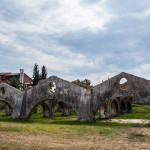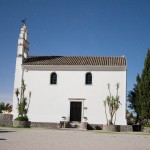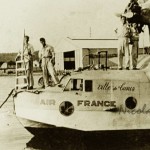Map
Venetian Shipyards (Neorio)
At the historical village of Gouvia, at the end of the Marina, lies the old Venetian shipyard (Neorio)
The Neorio in Gouvia is a remnant of a bygone era. Its skeleton stands today.
In the early years of the Serenissima Venetian Empire, its ships docked in Mandraki, at the Old Fortress of Corfu town.
Soon, however, the need for a greater military port with spacious warehouses and dry docks arised. The bay of Gouvia, seven kilometers northwest of the town was selected for this purpose . The depth in the area is 4-5 fathoms and the narrow mouth of the inlet needed no defense works.
The Ottoman army, under the command of Hayreddin Barbarossa, disembarked at Gouvia for the first time on August 29, 1537
Read More...The Ottomans, having destroyed the central part of Corfu island, then moved on to the town and unsuccessfully besieged the Old Fortress.
In the late 16th century, the port could accommodate 25 galleys.
In 1716, when the Ottomans attacked Corfu for a second time, they again disembarked in the same place.
After repelling the attack, the Venetians decided to fortify the position and
after the siege of 1716 they began to construct the Neorion facilities.
At the shipyard they held the winter maintenance and repair of all ships anchored in Corfu. In the late 16th century, the port could accommodate 25 galleys.
In the last years of the Venetian occupation, the facilities were neglected and the entrance of the bay had become problematic due to deposition of large volumes of sand by currents and southeastern winds.
The Democratic French also used the Neorion facilities, while in 1798 the Russian and Turkish fleet anchored there.
The siege of the Russians to occupy Corfu began on November 4, 1798, but the attackers decided to wait on the Turkish aid before attempting a landing. On November 13th, a small Russian contingent made a landing and managed to secure a small enclave in the area of Gouvia, where they installed cannons which fired against the fortresses of the island.
Aid finally arrived in February 1799 and numbered 4,000 Turkish and Albanian soldiers. On the morning of February 28th began the invasion of attacking the Vido island, which was occupied in two hours. The next day began the cannonade of Corfu fortress in Vido, the Russian enclave of Gouvia and the Russo-Turkish ships, while the attackers managed to occupy the three forts of the town. Admiral Ousakof intended to attack the two main fortresses of Corfu town, but the next morning the French side called a 48-hour truce to eventually be delivered on the morning of March 3rd.
In 1807 with the return of the French Empire, the French built three new emplacements in the bay mouth, which served as forts. One of them is the Scarpa fort. The bay of Gouvia was last used by a naval ship in 1814, when a British corvette anchored in its waters.
The subsequent history of the region is rich and interesting. It concerns the creation of the French seaplane base in 1916 as well as the disembarkation of the Serbs. It was also used in 1918 by the US Navy, as a basis for high-speed Sub Chasers which participated in the blockade of the Strait of Otranto.
During the midwar years French seaplanes carrying mail and passengers again used the area until the beginning of the Second World War.
During WWII the facilities hosted seaplanes used by both the Italians and the Germans.
Nowadays the area is used by modern seaplanes.
Beach
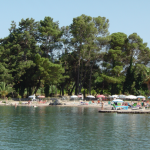 Lorem ipsum dolor sit amet, consectetur adipiscing elit. Ut diam diam, luctus vitae eleifend sed, aliquam eu lorem. Maecenas a ultrices dui. In accumsan ex eu ultricies imperdiet. Donec ullamcorper turpis vitae lacus fermentum, cursus laoreet diam scelerisque. Duis sit amet eleifend lorem, fermentum dapibus mi. Aenean efficitur pharetra sem, et aliquam metus maximus eu.
Lorem ipsum dolor sit amet, consectetur adipiscing elit. Ut diam diam, luctus vitae eleifend sed, aliquam eu lorem. Maecenas a ultrices dui. In accumsan ex eu ultricies imperdiet. Donec ullamcorper turpis vitae lacus fermentum, cursus laoreet diam scelerisque. Duis sit amet eleifend lorem, fermentum dapibus mi. Aenean efficitur pharetra sem, et aliquam metus maximus eu.
The Ipapanti Church
Rare is the visitor to Corfu who fails to pause in wonder at the beautiful Bay of Gouvia. The abundant shades of green on the land and the sparkling blue of the sea embrace the jewel of the bay, the Church of the Ipapanti of Christ – the church of the purification of Christ. This exquisite church, which used to be called The Church of The Pentecost, was built in 1713 during Venetian rule by Daniel Kombitsi, the offspring of a Cretan aristocratic family who came to Corfu in 1669 after the fall of Candia, modern day Iraklion. Daniel Kompitsi also built the monastery of The Apostles St.Peter and St. Paul in the village of Kombitsi. Originally the Ipapanti Church contained valuable works of art of the Cretan school that the Kombitsi family had brought with them from Crete. Rumour has it that Daniel Kombitsi died insane after the death of his son and the family subsequently disintegrated. All the Kombitsi property, including the Church of the Ipapanti of Christ, passed to the Theotoki family and was afterwards bought by the Italian family Scarpa. During his lifetime, Dr. Yannis Scarpas cared for the church but after his death his heirs did not continue his interest and the church gradually fell into a state of disrepair. Bats nested in the broken roof, rainwater soaked through to the interior and waves eroded the foundations on the south-western side. The narrow strip of land, some 60 meters in length, which joined the church to the mainland was frequently rendered all but impassable during the winter months as the sea waters rose. Time had embarked on its ruinous course. Spiros (Tzavros) Metallinos was the protagonist who, with the help of the local press, originally tried to raise interest in saving the church. He, together with a number of people equally concerned about the fate of the church, formed a fund-raising committee with the aim of the complete restoration of the church. The committee consisted of the parish priest of Ag. Panton Church, Josiph Georgoulas, Eleftherios Lingos, Konstantinos (Tzavros) Metallinos, Maria Mikalef, Stamatis Montsenigos, Georgios Spirou, Ilias Vasios, Yannis Lingos, Nikolas Bakolis and Spiros Doukas, In 1996 work began on the restoration of the church, thanks largely to the tireless efforts of Eleftherios Lingos. He was supported in his efforts by members if the committee and with the help of financial donations made by members of the Christian community. Mr. Lingos made every effort, with the assistance of engineers and the archaeological authorities, to restore the church to its original form. Everything remained as it was. Stone by stone the chiselled Baroque style iconostasis was dismantled and restored to its original form with the exception of the few pieces that time had eroded and which were repaired. The altar stone as well as the iconostasis and the stairs are all made of traditional Corfiot stone. The rest of the contents of the church, except fot the Cross, are donations from the Christian community. Today an environment of beauty and tranquility has been created where visitors can relax on the stone benches and enjoy the church and the unique scenery of the Bay of Gouvia. The church celebrates two feast days; its own feast day on 2 February and on 17 July, the feast of Ag. Marina.Read More...
Serbians Monument
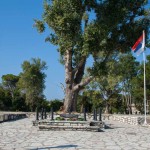 Serbs called Corfu the “island of salvation”, after the biggest exit in their history with roughly 250.000 people who had died on the long way through the Balkans to the Adriatic sea. Thousands of them were transported with the help of French and Italian ships from the Albanian port of Avlonas (Valona) to Corfu.
Serbs called Corfu the “island of salvation”, after the biggest exit in their history with roughly 250.000 people who had died on the long way through the Balkans to the Adriatic sea. Thousands of them were transported with the help of French and Italian ships from the Albanian port of Avlonas (Valona) to Corfu.Read More...
The salvation was followed by the loss of thousands by illnesses.
King Karagiorgevich of Serbia went to Vidos for the unveiling of the stone cross in 1922. The mausoleum was constructed in 1936.
For the future and happier generations, the island of Vido will become the Serbian Jerusalem, a place of gathering of our grateful descendants.
(Dimitrije, Metropolitan of Serbia, 1918.)
At the place where the Serbs disembarked, 8 Km to the north of the town at the gulf of Gouvia, a memorial plate reminds us of that event.
On that plate we can read in french, greek and serbian : At this port of the island of Corfu, the Serbian allied army had disembarked from 6 Jan. 1916 to 5 Apr. 1916, which passed through Albania
The reasons of its construction are the same as those for which the mausoleum was constructed, emphasizing the place where they arrived.
LINK: http://4lyk-kerkyr.ker.sch.gr/comenius1/abs_greek_loc3a.htm
A Bit of History
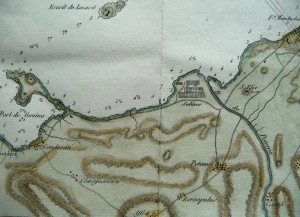
Map 1822 Gouvia appears as port de Govino.Photo by N.Desillas
Gouvia is the name of a small village laying on a side of the bay of Gouvia or Govino. It is at 7 km from Corfu Town and it is a part of its municipality. Gouvia bay is a closed bay and thus a natural port.
While standing on the pebble beach of Gouvia, one can see in the horizon the low hills and also high mountains of both Albania and mainland of Greece. Also on the other side of the bay, towards the North-East, you may see the residential area of Kommeno, with more and more villas every year.
Read More...In the middle of the bay lies the small church of Ipanpandi (Presentation to the temple of Jesus Christ) linked to the land by a causeway. This church used to belong to the Noble family Scarpa and was given to the parish of Gouvia by the last representatives of this family. Since then and under the control of the Byzantine Ephorate (service of Byzantine Archeology) the little church was restored with the generous donations of the inhabitants of Gouvia. It became one of the favorite churches to celebrate weddings and baptism. On the 2nd of February of each year, the people of Gouvia used to take their fishing boats to cross the bay and celebrate the feast of the little church. Especially married women who wanted to get a child used to make a wish there.
Before 1981 there was no real beach in Gouvia but thanks to the good will of both Mr. Ioannis Kourkoulos, mayor of Corfu and the village council, two very important projects were accomplished: 1st is the “creation” of a non-existing beach which gave life to Gouvia and made it one of the most famous summer resorts on the island and 2nd is the installation of the first sewage plant on the island of Corfu but it was also the first one built in a village in whole Greece ! Since then Corfu was doted by a huge modern sewage plant serving all Corfu town and its suburbs including Gouvia.
According to the local religious tradition, during one of the Ottoman Turks attacks in the 16th century, the Turkish fleet entered the bay of Gouvia to disembark and then march towards Corfu town to make its siege. At a certain moment a big storm blew and their fleet was in danger but also their gun powder got wet. So they had to lift the siege and leave promptly Corfu. The people saw in this a miracle of St Spiridon, the patron saint of the island.
Along the beach of Gouvia towards the South, you may find the monument of the Serbs made of granite on which an inscription is graved in three languages: Serbian, Greek and French. It was erected by the Serbs to commemorate the disembarkation of the Serbian navy during the 1st World War on their head General Putnik coming on exile to Corfu. Every year in May and September many groups of Serbians coming by coaches visit this monument on which they put a big crown of bay leaves.
Around 1935 Gouvia has been the home of the Air France seaplane base. The base closed in 1940. It used to function as a refueling base for the sea planes of Air France which started their trips from France in destination of Indochina. Nowadays one can still see what remains of the pier where the seaplanes ported as well as what used to be the radio center of the base. Where now is located a simple football field used to lie a big shed belonging to the seaplne base of Air France, which is actually exhibited in western airport of Athens.
Just on in the same area one could see until today the huge arches of the Venetian Shipyard from the beginning of the 18th century. Unfortunately there was no restoration done since a long time .During the summer, the municipality of Corfu organizes some youth camps in tents under the arches. The shipyards were built by the Venetians in Gouvia bay as it is a natural port in which they could repair their ships and preserve them against storms and foreign attacks. For that matter they built at the entrance of the bay, in Kommeno a small fort, known by the inhabitants of Gouvia as the Fort of SCARPA. Some remains of the towers where they had cannons (called “Batteries”) still exist in a private property.
French seaplanes in Gouvia
On December 29th, 1915 a squadron of the French fleet captured Corfu without notifying the Greek Government.
The main aim of this operation was the transfer of French and Italian ships residues of the Serbian army which was defeated by the German-Austrian and Bulgarian troops .
Indeed they were transferred to Corfu, where they regrouped before movement in Thessalonica, to be put into battle at the Macedonian front.
Corfu was then the seat of the exiled Serbian government that was residing at the “Bella Venezia hotel.”
Read More...
Of course, the strategic location of Corfu has played an important role for the allies until the end of First World War.
The allies quickly realized the important geographical position of the island in their effort to tackle the increasing action of German submarines in the Eastern Mediterranean.
In the spring of 1916 the French created in Corfu a center of the French Naval Aviation (Aviation Maritime) and the first seaplanes made their appearance on the island .
The French built in the sea area of Gouvia (namely Govino Bay), one of the largest military bases seaplanes .The specific bay was ideal for the creation of such a base because the winds did not affect it
Thus was founded the K.N.A. (Naval Air Center) or C.A.M. (CENTRE D’AVIATION MARITIME).
It was equipped with the most modern seaplanes that existed at that time. It aimed to engage in antisubmarine patrols in the Ionian area and the wider area of the Adriatic.
The facilities were excellent . There were 11 wooden sheds coated with waterproof cloth on the roof, which were used for the storage, maintenance and repair of seaplanes.
Also there were a lot of wooden huts for the accommodation of crews, pilots and mechanics. There were at four least piers, where the seaplanes were tied. Artillery type «Madsen» of 8 m.m. were used for antiaircraft defence.
The seaplanes were shipped to Corfu on a ship of the French Navy, the «CAMPINAS» .
This was a relatively small vessel, about 106 meters long, although it looked huge, due to the sheds that it held on its deck for the transport of seaplanes.
All seaplanes that belonged to «CAMPINAS», had the code letter F on their fuselage
- Location
- Events
- Nightlife


